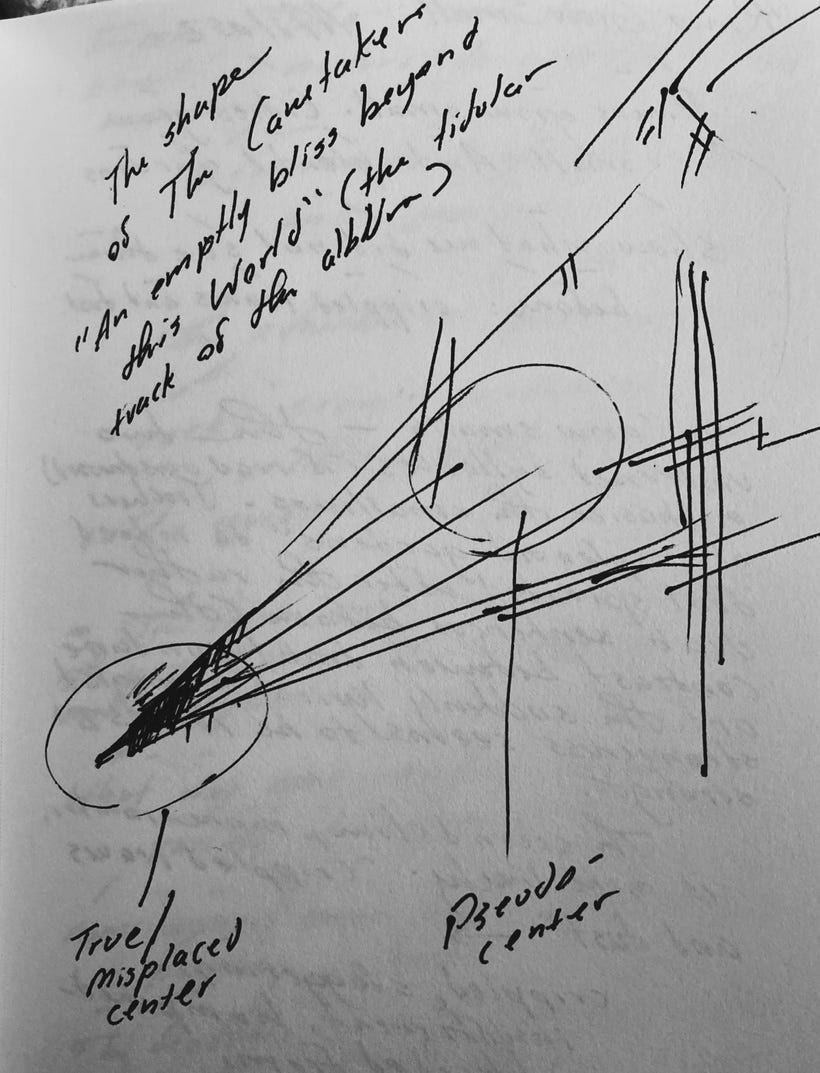It should be clear by now that the formless will never arrive separated from the guise of form.
Some weeks ago, I meditated to The Caretaker’s 2011 album, An Empty Bliss Beyond This World. I have found that music occurs in distinct “shapes” visible during meditative listening (an experience that, for me, entails quality headphones, a sleep mask, and a single-minded concentration on the music).
The Caretaker is the moniker by which electronic musician Leyland Kirby explores the deterioration of memory using sample-based structures. It is difficult to call Kirby’s pieces “songs.” They are repetitive and fragmented, relying on a prolonged effect akin to drone rather than alternating formal structures.
These fragmented and repetitive samples are culled from ballroom music of the 30’s and operate along a thematic and provocative relation to formlessness. First, they are distorted, reverb-laden, distinctively “ghostly.” This is due to Kirby’s preoccupation with the dissolution of memory, particularly in the case of Alzheimer’s, a theme further explored on The Caretaker’s magnum opus, Everywhere at the End of Time. As such, the form of the original sample is smeared, erased, and multiplied to mimic the deteriorations that occur in the mind during Alzheimer’s. Thus, each sample represents a recollected musical phrase or motif from the distant past, a discrete quanta of memory’s web. This movement can be interpreted as the encroachment of formlessness onto form.
Less intuitive is the element of formlessness entailed by the relentless repetition of samples. A sample is seared of its original context, often so that it may be situated in a new (and presumably surprising) milieu. In Kirby’s work, the sample’s relentless repetition itself becomes the context. The sample is not transposed onto a new landscape but stretched and multiplied so that it becomes the landscape—a form caught in an infinity mirror.
Interestingly, this move towards a heightened formal consistency, of uniformity, is also an intensification of formlessness. The lack of formal variation tends to weaken any sense of narrative, giving precedence to shape over notions of history, context, or any other linearity implied by causal progression. There is an emptiness here, a vacuous, spatial limitlessness that has led at least one reviewer to compare the album to Mark Z. Danielewski’s House of Leaves. Thus, the infinity mirror leads to the threshold of the labyrinth, a structure exemplifying the height of form and formlessness.
It is less the case that formlessness hides behind form. It seems, rather, that formlessness is indistinguishable from form. The intensification of form is an intensification of formlessness.
The rhizome, as described in Deleuze and Guattari’s A Thousand Plateaus, represents a well-known discussion approaching form’s tendency toward formlessness. In describing rhizomatic writing, D&G propose an abolition of “a tripartite division between a field of reality (the world) and a field of representation (the book) and a field of subjectivity (the author).” It is easy to see the rhizomatic nature of sample-based music, such as vaporwave (a genre heavily inspired by Kirby’s explorations, as well as similar forays by William Basinski in Disintegration Loops), if D&G’s distinction is transposed onto the world, the album, and the musician.
Like Kirby’s work, vaporwave is intimately tied to the act of listening to music in the lived environment. Kirby’s samples are remembered motifs (or what could be called quantifying “signatures”) from previous acts of listening to music. Vaporwave’s slowed-down, pitch-shifted, and distorted samples are unanimously connected to similar process of listening within a decidedly “postmodern gothic” context (soft rock from the 90s heard in the empty hallways of an abandoned mall, background music filtered through supernatural interference, the sounds an elevator ascending into the folds of an endless tower, etc.). The anonymous nature of the vaporwave musician (as discussed at length by Grafton Tanner in Babbling Corpse: Vaporwave and the Commodification of Ghosts), whose identity is often hidden behind a multitude of pseudonyms, further weakens any distinction between the world, album, and musician.
Vaporwave is about the act of listening / hearing music in the real world, music as it is heard in an environment, passively, distractedly. It is authorless, and unseparated from its being-in-the-world. It is rhizomatic, formless.
…Another glimpse of formlessness glowing across the [limits of?] our contemporary cultural landscape.
Author’s aside:
Thank you for subscribing to Form and Formlessness! I hope you’ve been enjoying my small forays into various topics. I only hope that things will get more varied and tangential as they progress. I just want you to know that F&F now has a YouTube channel where I plan to post occasional short videos and readings of various books related to this blook. There’s already a short video up—I'd heartily appreciate the subscription.
Please also note that I have a fiction collection of cosmic horror available from Journalstone Press. The Puppet King and Other Atonements has been called “a volume of first-rate significance” by Rue Morgue magazine, and “excellent” by Laird Barron. I’d be remiss not to ask you to consider ordering a copy, if you haven’t.
And briefly, a word on what’s to come. I’m currently reading Mark Z. Danielewski’s House of Leaves. Expect a series of short posts regarding this book, since it undeniably represents an extended meditation on form and formlessness in fiction. If you want to follow along and order a copy using the link above, I get a small percentage. I plan on keeping F&F entirely free, which means I’ll rely exclusively on affiliate links for the tiniest trickle of revenue.
Thank you again for your support! Please feel free to reach out to me at justinburnetteditor@gmail.com with any questions, suggestions, or to simply chat. Please know that I do tend to respond rather slowly.
Best,
Justin A. Burnett


